

THE LEADER

“We want [our students] to use the education to be leaders in their community with an understanding of ecology and conservation for the wild outdoors far beyond their legislators back home. We expect these people to be a grain of sand on the beach of future leadership.” —Paul Petzoldt
In 1965, Paul Petzoldt took students into the mountains to learn about living in the wilderness. Since then, the Leave No Trace practices we adhere to in the backcountry have grown and changed, but the essence has remained the same: take care of the place where you’re living to the best of your ability. That includes being a good steward of the global environment.
This ethic continues to inform our decisions and actions. Ten years ago, NOLS further committed ourselves to maximize our educational impact while minimizing our environmental footprint by setting ambitious goals for making our operations more sustainable. That commitment has included installing solar panels, using smart water conservation practices, and continuing to work with our partners internationally and in the U.S. to help protect the wild places we have the privilege to explore with students.
Our students are already seeing the impacts of climate change in the field. Glaciers in our wilderness classrooms are in retreat. Weather patterns are more extreme. Wildfires are more common. We know that to preserve these wild places—our classrooms—and ensure a stable and sustainable world for future generations, we must act now to reduce greenhouse gas emissions.
Many of the countries where we operate outside the United States are signatories to the Paris Climate Agreement. We support their commitment to these accords. Our own sustainability goals—for reducing 20% of our greenhouse gas emissions by 2020 and 80% by 2050—are in line with the goals for the same years in the Paris Agreement.
For these reasons—the practical conservation upheld by Paul Petzoldt, our mission, and our responsibility to the international community—we reaffirm our commitment to our values. We will continue to strive to be leaders and help others realize their own ability to lead and serve people and the environment.
Best,
John Gans NOLS Executive Director
August 2017 • Volume 32 • No.3 Published three times a year in April, August, and November.
EDITOR
Kim Freitas DESIGNERS
Kristen Lovelace
Liz Schultz
Nikole Wohlmacher
ALUMNI RELATIONS DIRECTOR
Rich Brame
NOLS EXECUTIVE DIRECTOR
John Gans
CREATIVE DIRECTOR
Brad Christensen
ART DIRECTOR AND DESIGNER
Eryn Pierce
EDITORIAL BOARD
Bruce Palmer
Anne McGowan
Pip Coe
Molly Herber
Postmaster: Send address changes to NOLS 284 Lincoln St. Lander, WY 82520
The Leader is a magazine for NOLS alumni. NOLS is a nonprofit global wilderness school that will help you step forward boldly as a leader. This magazine is mailed to approximately 71,000 NOLS alumni. NOLS graduates living in the U.S. receive a free subscription to The Leader for life.
The Leader welcomes article submissions and comments. Please address all messages to leader@nols.edu or call 1-307-332-8800. Alumni can send address changes to alumni@nols. edu or 1-800-332-4280. For the most up-to-date information on NOLS, visit www.nols.edu or email admissions@ nols.edu.
The Leader is printed with soy-based inks in Los Angeles, Cal., on paper using 10 percent post-consumerrecycled content. The Leader is available online at www.nols.edu/ leader.
Cover photo: Eric Page



SNEAK PEEK | IN THIS ISSUE

CURRICULUM | NOLS LEARNING GOALS AND OBJECTIVES
By Jamie O’Donnell, Expedition Curriculum Manager
We craft NOLS courses so graduates will be able to:
• Assume leadership roles
• Live and travel in the outdoors
• Act with confidence and competence
• Respect and collaborate with others on expeditions, on teams, and in communities
• Care for themselves and others
• Understand their strengths, habits, and areas for growth
• Function under difficult circumstances
• Make informed and thoughtful decisions
• Communicate effectively
• Connect with natural places
• Appreciate living simply
Read more on page 24.
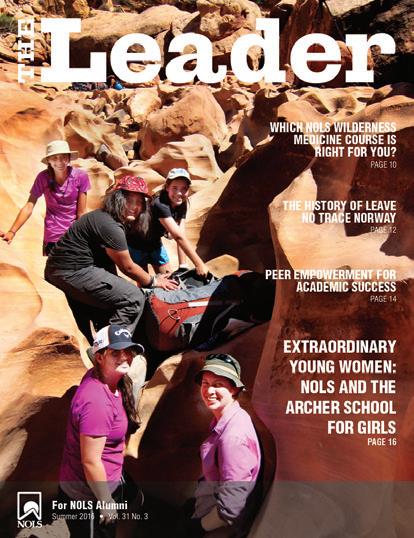



ALUMNI IN ACTION | DANGER IN THE DESERT
By Tod Schimelpfenig, NOLS Wilderness Medicine Curriculum Director
Treatment principles for a snake bite include:
1. Scene safety | Don’t create another victim by attempting to identify, capture, or kill a snake.
2. Calm yourself and the victim | Envenomation is not a given in a snakebite.
3. Immobilize the limb | Avoid compression or constriction of the extremity.
4. Transport to a physician/hospital | The treatment of envenomation is antivenom and supportive care.
5. Avoid unproven or discredited treatments | They may cause harm to the patient. (e.g., tourniquets, ice, electricity, meat tenderizer, incision, and suction).
Read more on page 12.
Love NOLS? Share your memories with us.
Send your feedback, artwork, photography, or personal story to leader@nols.edu, post on social media, or give us a call at 1-800-710-6657 ext. 2254. Find past issues online at www.nols.edu/leader.
NOLS IN ACTION | NOLS WILDERNESS MEDICINE AND MEDICAL SCHOOL
By Stuart Harris NOLS Board Member
Help, help!” Vincent heard the screaming coming from near the instructor’s camp. A student on NOLS Wilderness Medicine’s Medicine in the Wild course, Vincent was close to completing the final month before graduating from medical school.
Running under the ponderosas of the Gila Wilderness, he saw his head instructor down on the ground with a log across her leg and blood draining from an open wound. A fellow instructor lay at the other end of the broken branch with an obvious injury to his head. He wasn’t responding to Vincent’s call. Vincent could see how the tree branch supporting their bear hang had snapped. His mind raced. “What do I do?” And then his training kicked in.
Recalling next steps to respond from his Wilderness Upgrade for Medical Professionals (WUMP) course, a plan of action leapt to mind:
1. Get help. He yelled to his fellow students.
2. Assess the scene for safety. No other trees looked unstable. He moved towards his wounded teachers.
3. Patient assessment: ABCs. A: Airway. One instructor was speaking, one was not. Vincent ran to the second instructor’s side and calmly got to work. His fellow students started to arrive. Using the wilderness medicine skills taught only two weeks earlier, they brought calm to chaos. Fortunately, this incident was a practice scenario, a part of the course. In the critical debrief, the students’ response to the scenario was judged a great success.
NOLS Wilderness Medicine training provides a basic grounding in the principles and practice of improvised medical care. Whether in urban or backcountry
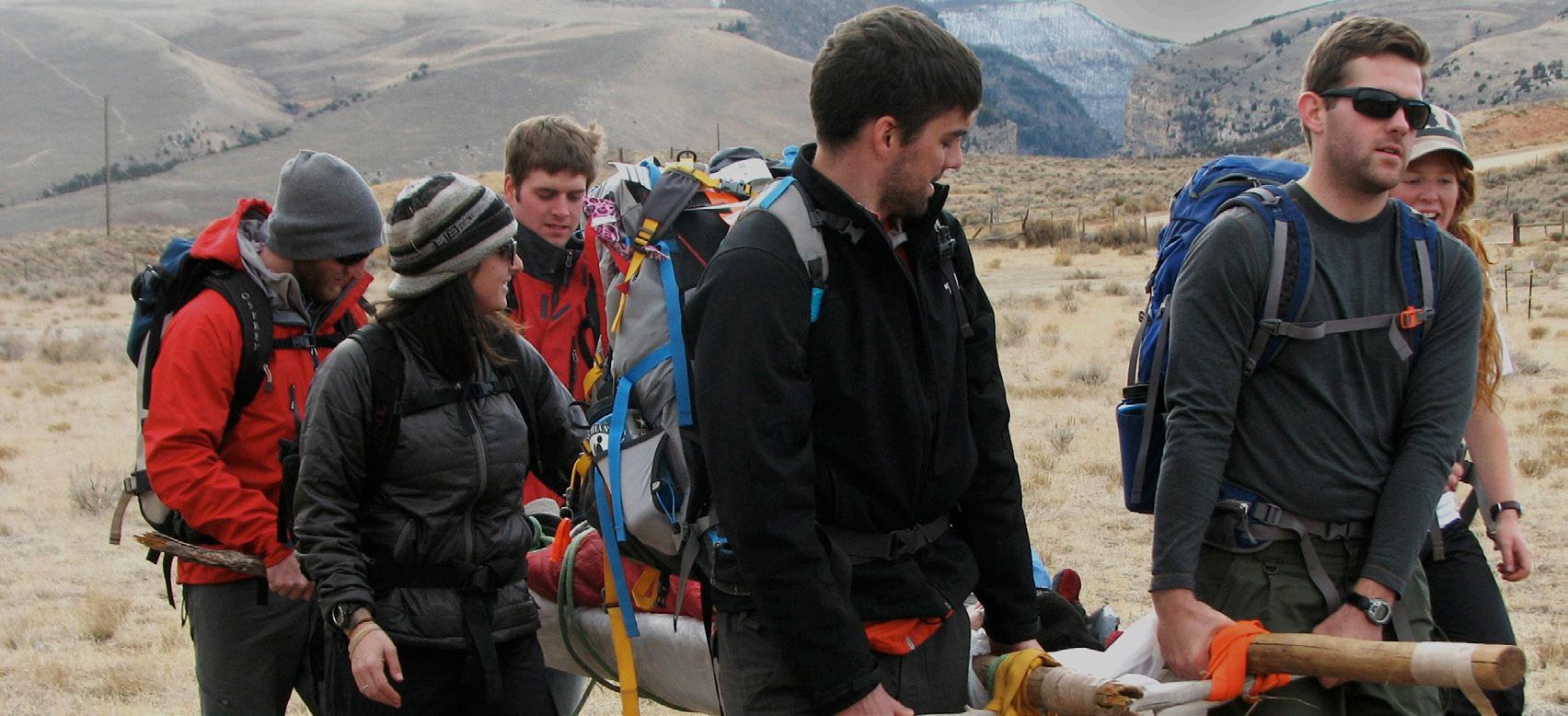
environments, NOLS Wilderness Medicine training teaches us how to react.
NOLS Wilderness Medicine courses can have a lasting impact and allow students to explore career options. This was my experience. As a college student, an introduction to basic wilderness medicine on a NOLS course ignited my interest in medical care and helped me to create a whitewater program. Suddenly, knowing the basics isn’t enough, and an EMT course seems a fun inevitability. Working as an EMT gave me critical pre-hospital experience and helped put me through graduate school. Now, from the seed planted by NOLS Wilderness Medicine training years ago, I work as an emergency physician, run a Fellowship in Wilderness Medicine, and collaborate with expert NOLS Wilderness Medicine instructors in the Gila Wilderness to teach the next generation of experts on a NOLS Wilderness Medicine course designed specifically for senior medical students.
Many of our students started their careers in medicine after similar early wilderness medicine training experiences ignited lifetime passions.
NOLS Wilderness Medicine training provides the quiet confidence borne of knowing what to do if bad things happen. For some, this experience can be life changing and lead to a profession in medicine that unites passion and profession. For me, that early experience has made all the difference.

Stuart is a NOLS Board Member, the founder and Chief of the Massachusetts General Hospital (MGH) Division of Wilderness Medicine, and the Director of the MGH Wilderness Medicine Fellowship.
NOLS Wilderness Medicine students practicing skills during a scenario. Marcio Paes Barreto
Stuart Harris

FEATURED LOCATION NOLS TETON VALLEY
By Ryan Hutton Operations Assistant
I’ve lived in Teton Valley, Idaho, about 30 minutes away from Jackson Hole, Wyoming, for almost 12 years, so when my parents asked if I wanted to do a NOLS course it only seemed fitting that I would do my course here. The Teton Valley location is a small, local, family-like location nestled in between Victor and Driggs, Idaho in a converted Mormon church. I started working here before my course in the summer of 2014 to help offset some of the cost of going camping for a month, and the staff took me under their wing. People helped me learn the systems NOLS uses, gave me responsibilities, and never got mad if I was late for work because every morning I had a nine-mile bike ride to look forward to
Since my summer in 2014, I’ve continually returned to the Teton Valley location for advice, work, and fun. I’ve returned to work for three summers because I like the people, the work, and the community NOLS has built in Teton Valley. This location specializes in adventure courses for 14-15 year-olds, including backpacking, rafting, and sometimes kayaking for either two weeks or a month. For me this is something comfortable because throughout high school I was close in age to all the students coming
through the location for these courses. I could relate to their excitement, apprehension, and hunger for something new; I’d felt all the same emotions when I’d arrived for my course four years earlier and every summer arriving to meet the new staff.
Teton Valley, Idaho is a special place; it has clean air, clean water, views of the mountains, and open spaces to roam in abundance. I see the Teton Valley location as a perfect representation of NOLS teaching in action; we are a community that wants to teach and lead others to be better than they were before. Our classrooms are the mountains of the Tetons, Palisades, and Big Horns. Our teachers are people who live the NOLS lifestyle on and off course, and the in-town staff are locals who want to share our home with people who want to see it.
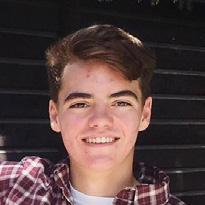
Ryan Hutton
Ryan is a kayaker, hiker, climber, and enjoys anything that takes him outside. He uses the Teton Valley as a playground to explore and have fun.
Location 1690 E 2000 S Driggs, ID 83422
43°41'39.2" N
111°04'02.6" W
In-Town Staff
Never more than 13
Operating Season
June through mid-February
Courses Offered
• Backcountry Skiing
• Backcountry Splitboarding
• Idaho Backpacking Adventure
• Salmon Backpacking and Rafting Adventure
• Salmon River Rafting - Prime
• Spring Break Backcountry Touring
• Winter Backcountry TouringPrime
• Winter Outdoor Educator
Fun Fact
You’ll find a rich landscape of granite cliffs, rushing whitewater, and some of the United States’ best snow, places where you can push yourself and expand your leadership skills.
Wilderness Medicine Quiz
QUESTION | What percent of our body’s surface area is represented by our hand (palm + fingers)? Answer on page 13.
Jared Steinman
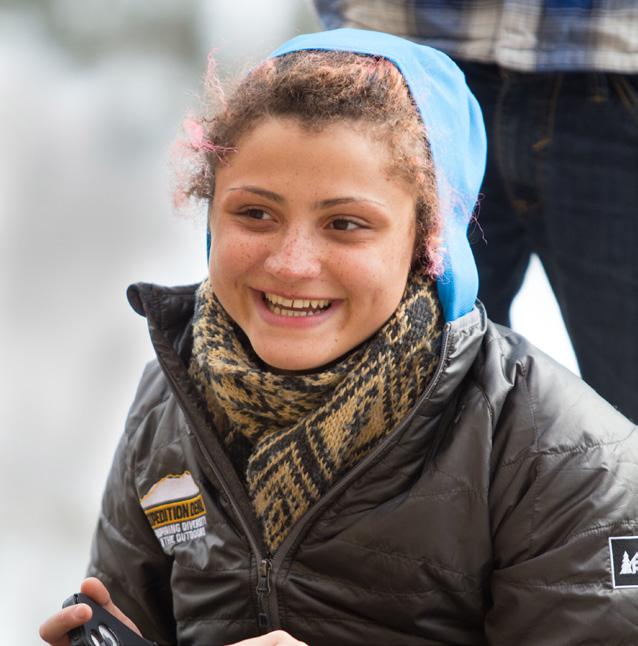
While no path with NOLS is the same, many would agree that Rosemary Saal’s has been wilder than most. Rosemary grew up living part-time in the Pacific Northwest and it was there that she got involved with the organization Passages Northwest (now Girls Outdoor Leadership Development with the YMCA). She participated in their

Taking in the view while mountaineering. Courtsey of Rosemary Saal
first ever mountaineering course when she was 17 years old. Of the trip in the North Cascades, she says, “I just remember thinking to myself, ‘Wow, I’ve been staring at these mountains my whole life and
STAFF PROFILE ROSEMARY SAAL
By Shelby Cranshaw NOLS grad
“I’ve been staring at these mountains my whole life and not once did I imagine them as a place I could go.”
not once did I imagine them as a place I could go.’ I think that’s what really got me into mountaineering—thinking back to that incredibly empowering experience of realizing how my body was capable of more than I ever thought possible.”
Rosemary had heard the name NOLS here and there, but wasn’t officially introduced to the school until she learned about Expedition Denali. Her first NOLS course, a Waddington Range Mountaineering expedition, was in preparation for the 2013 attempt up Denali, North America’s tallest peak, with a group of African-American climbers. She was the second youngest expedition member, at just 20 years old. From there, it has been full speed ahead with NOLS.
In 2016, three years after Denali, Rosemary returned for the Alaska Mountain Instructor Course. Saal explains, “I feel super fortunate to be able to spend so much time in the Last Frontier; I have a ton of love for that state. The fact that I’ve come full circle in a way was one of my favorite feelings coming off of the IC [Instructor Course]. When I initially went to Alaska for Expedition Denali all the way back in 2013, I didn’t expect that
this would be the same [location] I would return to to take the IC and work my first course. It’s wild, truly.”
When asked what keeps her motivated personally and as an outdoor educator she says, “Really, the awe I experience when out there is what does it. It is just unreal! It is definitely hard work, and I would be lying if I said I never had moments when I question why I choose to pursue this activity on purpose, but as long as I remind myself how fortunate and privileged, even, I am to be able to do this, I’ll have motivation to continue. What I really want is to be able to pass that same enthusiasm on to students.”
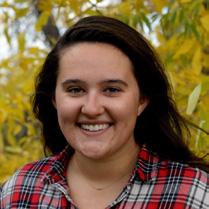
Shelby Cranshaw
After finishing her Fall Semester in Patagonia, Shelby moved to Lander and was the PR and Marketing intern for a year. She is currently a student, but hopes to return to the West after finishing school!
Wilderness
Quiz
QUESTION | What is the largest State Park in the United States? (Hint: It’s also home to the newest NOLS Alumni climbing trip.) Answer on page 30.

WALUMNI PROFILE DAVE DULONG
By Jen Pontrelli Custom Education Sales Manager
“Our first day on that tundra I took a few steps and thought: I cannot do this for two weeks.”
h en Dave Dulong took his first steps on the Alaskan tundra for his Brooks Range Backpacking course in 2005, he wasn’t quite aware of the impact those steps would have on his life. In fact, his uneasy footing didn’t inspire any positive thoughts at all.
“Our first day on that tundra I took a few steps and thought: I cannot do this for two weeks.”

At age 49, Dave was on his first NOLS course and in the midst of an important shift in his life. As a hard-charging software distributor, he had formerly been a heavy smoker and led a minimally active lifestyle. When he started dating his partner Nancy, a NOLS alumna and avid hiker, Dave began to take an interest in the outdoors and eventually signed up for the 14-day Brooks Range course along with her.
“It was life changing,” Dave said. “I was always the last guy up the hill. But I’d finally get there, huffing and puffing, and it was a huge awakening.”
After pushing his body to the limit for 14 days, Dave knew it was time for change. Upon returning to his New Hampshire home he connected with Team in Training, a leukemia and lymphoma fundraising and race training organization he learned about from his cook group, and set his sights on running his first marathon just after his 50th birthday.
Now in his early 60s, Dave is in the best physical shape of his life. He has run 15 marathons, including the prestigious Boston Marathon, and shows no signs of slowing down.
Having learned in the Brooks Range that they are compatible in the frontcountry and backcountry, Dave and Nancy eventually married. Ever partners in life and adventure, they continue to explore mountains all over the world on
NOLS Alumni trips.
In May 2016, they trekked up to Everest Base Camp at 17,600 feet. The notoriously precarious route was a new mental and physical challenge for Dave, who has a fear of heights. Never one to shy away from a challenge, Dave will continue to face down this fear in summer 2017 when he attempts to summit Gannett Peak, in Wyoming’s Wind River Range, on his ninth NOLS Alumni expedition. In true NOLS style, as he reflects on his late-in-life evolution into a mountain-climbing super athlete, Dave has no misgivings about his former lifestyle, but appreciates all that he has learned along the way.
“Look, you make decisions at the time with the information that you have. I have no regrets, but I sure am glad I’m at where I’m at.”
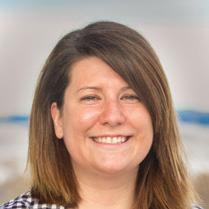
Jen Pontrelli
Jen is the sales manager for NOLS Custom Education and came to Lander from Chicago in 2015. In her free time, she loves to run, bike, explore the mountains, and bond with friends over homemade deep dish pizza.
On a NOLS Alumni trip in Italy. Courtsey of Dave Dulong

Th ere are wrong decisions and shades of right decisions,” Meredith Lantz says with a laugh as she explains the tools NOLS provided her in her path towards starting her business Bitters andBottles. “You get to NOLS and you have to plan and pack all of your supplies, you have to prepare yourself for this journey. It just doesn’t happen by itself. Planning is so important, I use that in the business world. The better you plan and prepare the better your experience will be.”
Meredith first came to NOLS in 1999, exploring the Alaskan wilderness and then mountaineering through the Wind River Range. As she shares her path to where she sits now, she says, “It’s what I learned in the mountains at 16.” Meredith moved to Italy without knowing the language, from there a move to London and then San Francisco kept her pursuing growth and new leadership challenges. Meredith knew from NOLS that, “Leadership isn’t just the person at the front of the line. A leader can and should come from the front, middle or back of that line.”
This idea took shape when she and her now business partner, Joe, sat talking about future dreams. Joe explained his love of the creativity of cocktails, and that he wanted to share this. Yet no company existed that created a perfect recipe box so Bitters and Bottles took form. “It took about a year and a half to go from
ALUMNI PROFILE MEREDITH LANTZ
By Liz Hall Development Officer
Follow along with Meredith and the Bitters and Bottles team @bittersandbottles
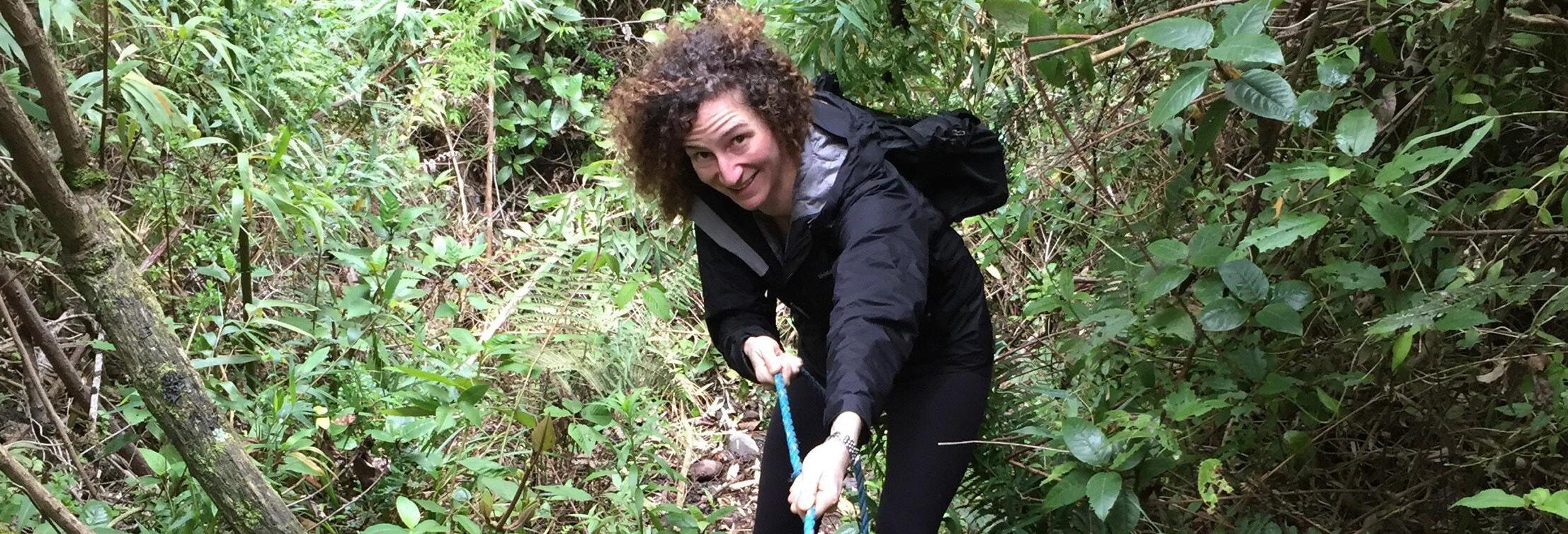
idea to doors open. In that time, we did lots of tinkering, creating, tasting,” Meredith shared as she reflects on the past four years. “We put our own money into it, we needed the business model to generate revenue immediately. Once open, we began building from there.” Meredith explained how NOLS gave her skills in this decision. “Out in the field, there’s no one else but the people around you and so you have to consider the consequence of your words and decisions.” These social dynamics helped make Meredith the professional person she is today. At Bitters and Bottles they assist their customers in creating the perfect and unique home bar. “We want to be the Bill Nye of cocktails at Bitters and Bottles! The store in San Francisco is a community place and is based in education and conversation.” Their growth has been slow but very
steady and they wouldn’t have it any other way. Faster growth would have meant compromising their brand definition and integrity. In reflecting on what she learned in the mountains, Meredith said, “There will be challenges and moments of insane doubt and it doesn’t make sense on paper, but if you’re confident in mission and product, that’s what you need to move forward.”

Liz Hall
When not on the road raising philanthropic dollars for NOLS, Liz loves traveling, reading, anything outside, and she is a devoted aunt.
Clearing trails in the Andes in Ecuador. Courtsey of Meredith Lantz
ALUMNI TRIPS
Continue your summer adventures by adding a fall trip with NOLS Alumni to your calendar. Our trips are for both our alumni and their guests, and these trips cater to the interests and maturity levels of our participants. Join a trip somewhere in the world that is new
NOLS Alumni Reunions
Spring 2017 was quite the Alumni Reunion season! Over 800 of you from 12 cities coast-to-coast heard instructors Katie Crafts, Rob Walker, and Zand Martin share their adventures; we hope you left inspired by their stories. We’ll hit the road again in the fall, so keep an eye out for reunions in New York, Chicago, the Twin Cities, and beyond. Reunions gather area grads to create a NOLS connection at the local level—isn’t it time you relived your NOLS experience?

for you and trust NOLS to run the show.
We have a wide variety of offerings every year and are quickly adding more trips for 2018. If you don’t see what you want, contact us; we build custom trips as well. For more information or to sign up, call 1-800-332-4280 or visit www.nols.edu/alumni
Rock Climbing - Adirondack Park - Alumni
DATE | September 17-23, 2017 (7 days)
COST | $1,750
We are bringing you a new climbing trip this fall! Based out of NOLS Northeast in New York, this trip heads into Adirondack Park for seven days of rock climbing. The Adirondacks span six million acres and are home to over 3,000 climbing routes. The shady granite crags, classic lines, sweeping vistas, and fiery foliage make it a perfect fall climbing destination.
Croatia Sea Kayaking - Alumni
DATE | September 15-21, 2017 (7 days)
COST | $2,350 includes pre-and-post trip lodging
Explore the Elaphiti Islands Archipelago with NOLS on this beautiful coastal trip! We leave the tents at home for this adventure, traversing the ocean by day, and staying in guest houses every evening. Starting and ending in Dubrovnik, you will soak in the Adriatic culture and culinary traditions with a group of other NOLSies.

Cass Colman
Christina Cune

FEATURED COURSE SEMESTER IN THE ROCKIES
By Derek MacDonald Marketing Representative
In an attempt to better understand myself and who I wanted to become, I took a step back from college in 2014 to embark on a semester course. Fumbling forward through the beginning of college, I found myself caught up in the rat race and anxiety of realizing that I was blindly on the assembly line of becoming an adult. I wanted a break from 200-person lectures, presentation slides, review sessions, and the stagnation of routine. I needed an adventure. NOLS seemed more engaging than a traditional study abroad experience; an entire semester to spend in the wilderness, off the grid and in the backcountry.
Those 90 days, 12 expedition partners, and 5 sections completely altered my perspective. Winter camping and backcountry skiing in Wyoming, a Wilderness First Responder certification, whitewater canoeing and river camping on the Green River in Utah, a month of backpacking through southern Utah’s canyons, and rock climbing in Colorado shifted my view of my own connection

Insider
NOLS invented the outdoor semester, and this course is where it all began. It gives you a complete set of skills to lead and teach in the backcountry.
to the outdoors from hobby to lifestyle. I even received academic credit for it!
I chose the Rockies semester because of the winter section. I had grown up a snowboarder, and a chance to learn more about winter camping and backcountry travel in the mountains was very appealing. While I had been primarily focused on the snow, it was the water that had the largest impact on me and swept me away. I had never been whitewater canoeing or river camping. That allowed me to approach the section as an open-minded beginner who was eager to learn, and emerge a competent paddler capable of leading others.
My classroom consisted of 122 miles of winding whitewater rapids between the walls of Desolation and Gray canyons.
We rose and slept with the sun. We spent our nights sleeping under the starriest skies we had ever seen instead of in our tents. Our instructors were phenomenal. Their mastery of their craft was inspiring, their knowledge seemingly endless. From communication skills and
group dynamics, to local environmental ecology, to decision making—they were driven to impart their wisdom on us and watch us implement what we were learning. They also genuinely enjoyed fostering meaningful relationships with us. Their mentorship remains rooted in my own inner compass and self-direction.
That semester affirmed my love of the outdoors and created acknowledgement and acceptance of it. I learned that the outdoors is where I find purpose and passion. Sharing that with people is what makes me happy. You can’t know that something is missing until you’ve been exposed to it.

Derek MacDonald
Derek currently works as a marketing rep and event manager at NOLS. Recreational fun-haver and backpacker, he’s happiest chasing sunrises in the backcountry.
Derek MacDonald Wilson Cheung
ALUMNI IN ACTION | DANGER IN THE DESERT
By Roland Schumann NOLS grad
My wife and I came upon a group of people tending to a 26-yearold hiker who was bitten by a rattlesnake, late in the afternoon while hiking up Palm Canyon in the AnzaBorrego Desert State Park in California. It started as a normal day, and then it wasn’t. She had been climbing a steep face and reached up to a ledge where, unbeknownst to her, a rattler was enjoying the sunshine. Fortunately for her, she managed to hold onto the ledge despite being bitten on her fingers. Her climbing buddy helped her safely descend to the canyon floor and had her sit down along the hiking trail. That’s where we found her.
The people initially trying to help her had taken basic first aid courses, but were unprepared for this event. I identified myself as a Wilderness First Responder and offered to help. There were
lots of challenges, including no medical supplies or cell phone service. A runner was dispatched to run down the trail to a point approximately 1.5 miles away where he could call 911. Given the rugged terrain and the stress her body would be subjected to during a hike out of the canyon, it was clear we needed a helicopter.
I started taking and recording vital signs and providing comfort to the patient. The SOAP app on my iPhone was very helpful for logging the information. I was grateful the patient was fit and otherwise healthy, but as the minutes ticked by, and as the venom worked its way through her body, she began slipping into shock. She rated the pain level as 9 out of 10. Providing reassurance and a soothing presence was instrumental to keeping her panic-response in check. The swelling in her hand and arm was
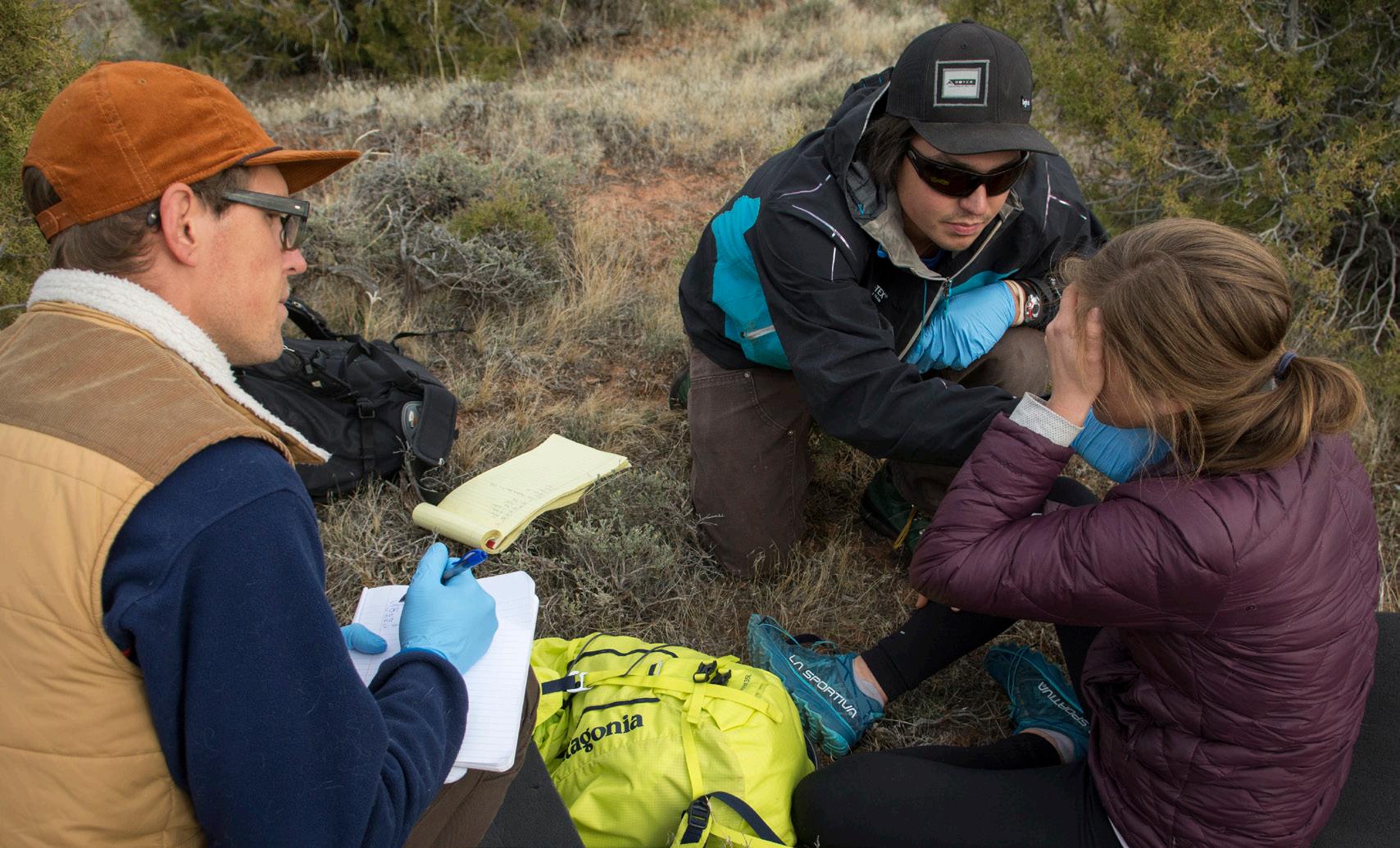
severe. Compartment syndrome was a very real risk in this situation.
Almost 1.5 hours had passed since the bite occurred and the patient’s condition was deteriorating. Her respiratory rate and heart rate were climbing, while her level of responsiveness was decreasing. She began vomiting. Thankfully, three minutes later the helicopter arrived.
The walls were too steep to land so they lowered a paramedic by the hoist. Shortly after that, two other paramedics arrived after hiking in from the trailhead. I briefed them and handed off my patient. She was quickly placed into a harness alongside one of the medics and hoisted up to the hovering aircraft.
We heard later that the patient required multiple vials of antivenom and spent nearly two weeks in the hospital. Although she survived the initial trauma and was released from the hospital, her hand was still in rough shape. The recovery time from a rattlesnake bite can drag on for months to years.
Again, it was not a typical afternoon. I am just thankful that I could be in the right place at the right time to help.
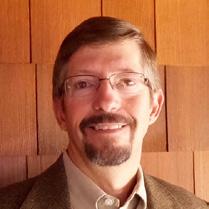
Roland is a tech entrepreneur and backcountry enthusiast. When he’s not skiing or hiking in the backcountry surrounding Lake Tahoe, Roland keeps busy mentoring tech startup CEOs and helping them grow their businesses.
Taking and recording vital signs of a patient. Jared Steinman
Roland Schumann
FACULTY AWARDS | 2017 WINNERS
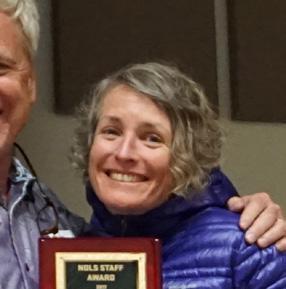
The Combo Award recognizes a faculty member who has had a successful career teaching both in the field and in town.
This employee came to NOLS in 2001 on a Professional Instructor Course. She worked a fall semester section and has been hiking, climbing, and playing in the winter since.
When you look at the list of contracts she’s worked, you see an incredible range. What’s even more incredible is the consistency of high student outcomes across this range. When commenting on her performance, students note “she blends authority with camaraderie and wins respect” and

“She’s just a fantastic human being, and I’m fortunate to see how she carries herself. She’s an inspiration to me.”
She earns praise from semester students, Instructor Course students, middle-school students, wildland firefighters and Google directors. She demonstrates the aptitude to work with anyone.
Since 2011, she has also worked as a program supervisor. Her fellow staff find her contributions to be invaluable. For her 17 years of teaching in the field and classroom and her 7 years of program supervising, please join us in congratulating Combo Award winner, Kate Koons.
The Faculty Award recognizes a field instructor for their work teaching students technical skills and leadership in the wilderness.
This Instructor came to NOLS on an Australia Backpacking course in 2002 and returned in 2003 for her Instructors Course here in Lander.
Though she can, and does, hike for NOLS, you’ll primarily find this instructor on the ocean.
On the ocean, and on land, her students regularly share how much they benefit from her leadership. One student recently said, “I appreciate your transparency and willingness to bend and change your style to better fit my needs. Your communication is stellar. It was awesome

working with you and learning from you.”
A supervisor wrote recently, “You can tell she had an intentional formula for student leadership development, which led to a studentled course. She built rapport and engaging student relationships, despite maintaining expectations in this boundary pushing group.”
She has also contributed as a program supervisor, and her contributions to development of the sailing program have been exemplary. She has trained supervisors who aren’t sailors to effectively support sailing teams at a very high level.
Please join in congratulating the winner of the Faculty Award, Cass Colman.
The Plotkin Award recognizes extraordinary achievement and exemplary communication, in mentoring students in leadership, risk management, and decision-making.
Our recipient came to NOLS in 2009 as an Amazon Semester student. He then aided two hiking courses before taking an Instructor Course (IC) in 2011. His IC instructors noted his clear communication in risk management situations, his confident leadership, and his keen awareness of the importance of community.
A recent colleague appreciated his ongoing positive feedback, attention to coaching students, ability to find teachable moments in which to deliver leadership curriculum, and his focus on fun. Another noted his effective
teaching of the leadership and risk management curricula.
A recent supervisor wrote, “He delivers quality, constructive feedback in a way that can be heard not just by students, but by all faculty and staff at the school. He is constantly looking at ways to innovate our briefing and debriefing systems.”
This instructor has 7 years and 125 field weeks hiking, sea kayaking, guitar playing, and having fun. He also has seven years of investing in students and building strong relationships from which to teach and coach leadership and risk management.
Please join in congratulating the winner of the Thomas Plotkin Award, Yuri Parkinson.
Wilderness Medicine Quiz
ANSWER | 1%. This helps judge how large a burn is on the body and make a decision about evacuation.
Kate Koons Combo Award
Cass Colman Faculty Award
Yuri Parkinson Plotkin Award
A NOBLE PATH
By Dan Kenah Foundation Relations Officer
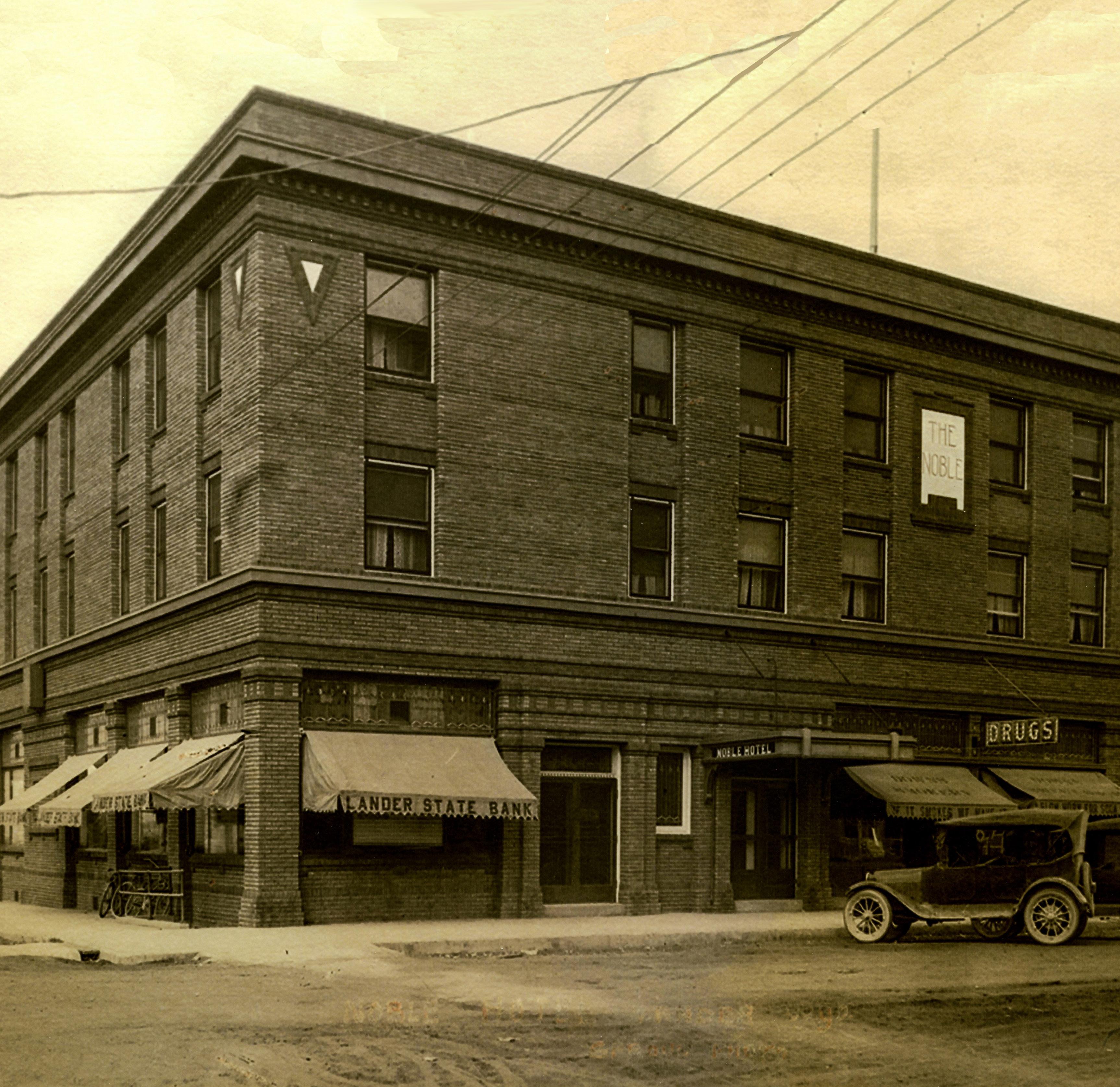
In August of 2018, the Noble Hotel will turn 100 years old. As we celebrate its storied history, we tip our hats to its past and consider how it will take NOLS forward into our next half century.
From its luxurious founding as a jumping off point for wealthy Easterners en route to Yellowstone, to housing Curly’s Bar where Paul Petzoldt started scheming his outdoor leadership school, the Noble has long ushered people from comfort into the unknown. Even now, after having been restored to its old beauty five years ago, it fills a modern version of its original purpose: a temporary home for students and instructors on their way into the wilderness.
When it was first conceived by the entrepreneur H.O. Barber in 1917, Lander was the last stop on the Great Northern Railroad. After a year of construction, the Noble opened its doors in 1918 for tourists from cities like New York and Chicago as they made their way to adventures in Yellowstone and beyond.
Complete with fine silver cutlery and cut glass, mahogany and marble decorations, an intricate stained-glass ceiling, and mounted game heads, it was a visual and literal waypoint between the worlds of East and West, between the known and the wild.
That tradition continued after H.O.’s death in 1929 when Harold Del Monte bought the building. Beyond just grand accommodations, the hobby historian wanted the Noble to tell a story of the early West. He commissioned artists and furniture makers to redecorate the hotel
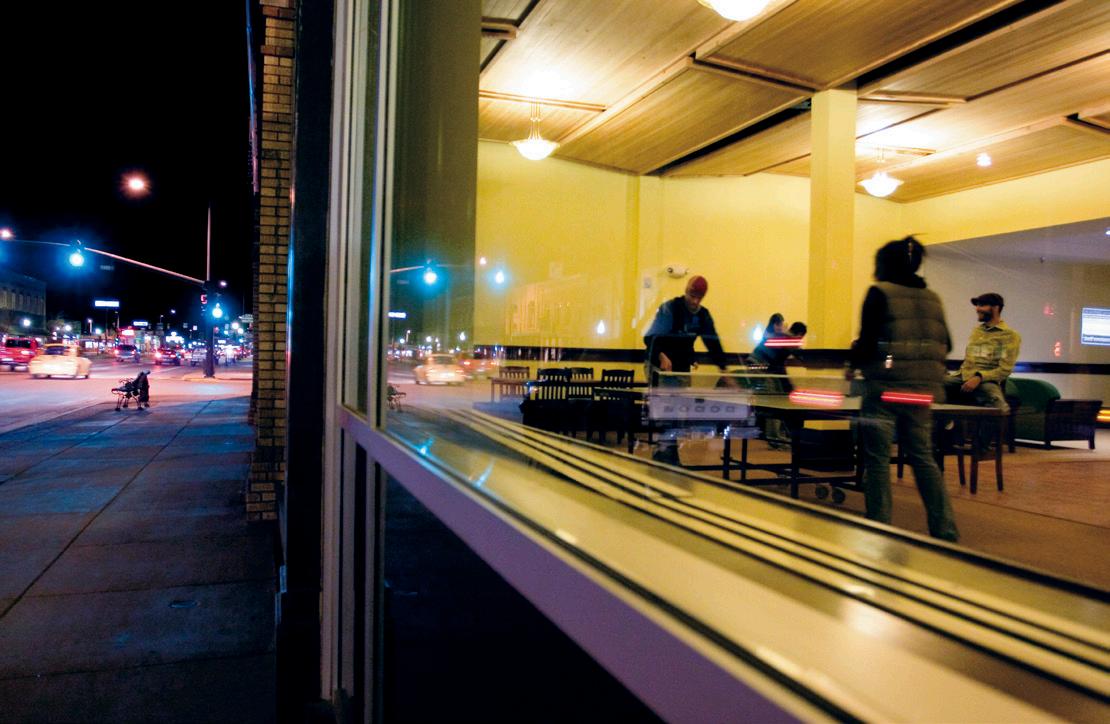
with murals and paintings depicting Western scenes, cowhide leathercovered tables and chairs, and ten rooms with themes from early fur trappers to contemporary cowboys.
It was with that same spirit of new adventure that Paul Petzoldt decided to launch the National Outdoor Leadership School, now NOLS. After years of mountaineering and guiding he wanted to try something new, to teach students not only how to enjoy the wilderness themselves, but how to lead others responsibly.
NOLS finally bought the Noble in 1973, beginning its current role as a home for students and instructors for the days before and after

their NOLS Rocky Mountain courses. From that time through today, it has been the last vestige of civilization before students embark on a NOLS adventure. Upon their return, it often represents the first hot shower they’ve had since they left weeks earlier, the first hot meal they didn’t have to cook themselves, and the first time they haven’t slept on the ground!
During my first two weeks in Lander, I lived in the Noble myself. I crossed the Italian tile floors with the aroma of student meals wafting from the dining room, climbed the creaky stairs past photographs of Chief Washakie and his ancestral lands, and saw some students excitedly meeting for the first time while others said their tearful goodbyes.
Sitting now in a knotty pine chair, in the soft yellow-white light of the stained-glass ceiling under the gaze of elk, moose, deer, and bison who have seen so many thousands of such students pass through this lobby, I’m encouraged to think that the Noble will continue to hold its place in Lander’s history and ours, as the place where the rails end and the trails begin. Where we leave behind certain comforts for uncertainty, lace up our boots, and confidently step into an unknown future.

The stained glass ceiling inside the Noble Hotel. Brad Christensen
Students playing games in the common room. Brad Christensen
Left: The Noble hotel during the 1920’s. NOLS Archives
Dan Kenah
Dan is a Baffin Island 2006 grad and recently joined NOLS as the foundation relations officer. The former ski bum loves hiking, rafting, and playing the piano.
TALES FROM THE TRAIL
By Kim Freitas Writer and PR Specialist


My own NOLS course was four years ago, but I still remember not knowing how to stand up with my backpack, slowly marching up the switchbacks into the wilderness thinking, “What have I done?!” and breaking down crying thinking I’d never find a job after it was over. In that month of quiet hiking, I dealt with physical challenges, stopped worrying about what my life was going to look like after college, and explored the Wind River Mountains. I was not alone in this, as most students have transformational experiences on their course.
To share the impact of student experiences with the greater NOLS community and those not familiar with NOLS, as well as inspire folks to take a course, NOLS created a video series showcasing student voices. These videos, called Tales From the Trail, feature students chatting about the most memorable parts of courses, their personal growth, and big takeaways from NOLS.
One student who told his story was Chris Whitmore, who signed up for an Alaska mountaineering course “So that I could learn how to do high alpine-style climbing, get through technical terrain, and never have to get a guide again.” As a rock climber and ice climber, he was most excited to learn new technical skills. “The thing that probably surprised me the most was how to be comfortable in uncomfortable situations.” Chris realized he wanted that mental challenge in addition to the technical skills he’d come to learn.
The course he signed up for was an ambitious thirty-day mountaineering expedition through the Chugach Range in Alaska. “It was this landscape that was just untouched, and it just started to settle in, that’s where we’ll be living for a month,” said Chris. It was like nowhere he’d ever been before.
INITIALLY EVERYONE HAD ACTED SUPER INDEPENDENTLY. BUT
THIS IS THE FIRST TIME THAT WE ALL REALLY CAME TOGETHER.
Chris and his coursemates quickly found out mountaineering was hard work. He grew up snowshoeing in Minnesota, but this course was a new challenge of snowshoeing with a 70-pound pack. “Whenever we’d stop and look around [we thought] this is why it’s worth it all. Because this view is not something everyone gets to see.” The course was so remote that they were dropped off, rationed, and picked up by plane.
When a bush plane pilot flew in with news of bad weather, the group came together for the first time to get camp ready for the storm. It took almost seven hours of straight preparation to stormproof camp.
Prior to this storm, “Initially everyone had acted super independently. But this is the first time that we all really came together. We stomped out each other’s platforms. We dug for ice anchors. We had to build these snow walls around each of our tents to protect ourselves.”
It was a new level of expedition behavior, as well as the beginning of common ground for the coursemates. Late arrivals to camp were handed a warm meal, sipped hot cocoa, and crawled right into their sleeping bags.
“Regardless of that situation, we were still having a good time and that’s the epitome of what mountaineering can be, I think. It’s just having those things stacked up against you, and still getting through it. It is just pretty remarkable to have us go from 16 pretty different individuals to one cohesive team.”
From pizza baking the first night, to ice climbing the second day, to preparing camp for a storm, the impact of Chris’ mountaineering course was significant. To learn more about Chris and watch other Tales From the Trail videos, visit: https://info.nols.edu/ tales-from-the-trail.

After the storm. Courtesy of Chris Whitmore

Kim is a Wind River Wilderness, Wilderness First Responder, and Alumni Winds Traverse graduate who works as the NOLS writer and pr specialist. She enjoys vegetarian cooking and running half marathons!
Left: Chris heading into the wilderness for his NOLS course. Illustration by Grand Army
Kim Freitas
DELIVERING FOOD AND MORE
By Anne McGowan Development Communications Coordinator

Rerations. For students on NOLS expedition courses, this word conjures up visions of abundance—more hashbrowns, more trail mix, more cheese—hauled into camp on horseback, by airplane or boat— just as food supplies are starting to run low.
Rerations seem to appear from practically nowhere. Brought to courses partway through, they make carrying enough food for an entire course easier. Of course, a reration is not really magic: it’s the hard work of individuals and animals carrying in items such as pasta, peanut butter, and granola to hungry students.
Kay Harris has rerationed NOLS courses in the desert Southwest for almost 35 years. Based in Cedar City, Utah, he was already the go-to rations guy in the canyons before completing a Summer Instructor Seminar in 1991.
“Kay is an amazing man,” NOLS Rocky Mountain rations manager Claudia Pearson said. “He’s humorous, talented, and so consistent. Students love him. As long as I’ve worked at NOLS, since 1978, I don’t remember anyone else rerationing in the canyons.”
HE’S
HUMOROUS, TALENTED, AND SO CONSISTENT. STUDENTS LOVE HIM.
Kay remembered that former instructor Adele “Del” Smith “kind of conned me into doing my first reration.” Del, who knew Kay through their shared work with troubled youth, asked him to accompany her on a NOLS reration in the fall of 1983. When Kay agreed, Del asked if, by the way, they could use his fourwheel drive truck to make the drop.
“That’s how it started,” he laughed. By the next spring, Kay was rerationing semesters on the Grand Canyon’s North Rim and near Escalante National Monument. Soon, that included drops all over Utah and Arizona.
Kay can’t count how many he’s worked over the years, but agreed he’s handled almost every NOLS reration in the canyons area. More recent figures are easier to come by: He ran 28 rerations last fall and 18 this spring, numbers he calls typical.
Andy Blair, NOLS Rocky Mountain assistant director, said everybody loves him. “Kay brings so much more than food,” he said.
That includes a spiritual component, holding sweats for courses, and teaching students how to make flutes.
Kay explained he’d been holding sweat lodges, spiritual ceremonies central to many Native American cultures, in his previous work with troubled young people, giving them something to hold on to as they faced challenges. He didn’t see NOLS students in the same light, but saw value in exposing them to spiritual elements of the area’s indigenous people. One long-time staffer described it as “introducing a cultural component to courses before it became part of NOLS’ curriculum.”
Kay was concerned NOLS might fire him because of the sweats, but when that didn’t happen, he tried to hold a sweat for every semester course he rerationed. The sheer number of courses now makes that more difficult.
A devoted husband, father, and grandfather, Kay also owns and operates Canyon Expeditions, a river rafting company, raises cattle,


Top: Kay on a personal trip in the canyons. Andy Blair Bottom: Enjoying time off from work on the ranch. Sue Harris
and sells the hand-carved wooden flutes, signage, and caskets he makes.
“As far as making a living, I’ve tried to stay independent,” he said. “I like a lot of variety. I like the unknowns in life, because they turn into adventures.”
How long will Kay continue working as NOLS’ longest-running rerationer?
“Well, I enjoy it a heck of a lot, largely because of instructors and students,” he reflected. “Of course, I have their food and water, but they always make me feel good when I arrive. I feel like I can do this when I’m 100.”


Anne, a Pennsylvania native and former journalist, is the NOLS Development department’s communications coordinator. When she’s not reading or writing, she’s walking, hiking, chasing deer from the garden, and occasionally playing tennis.
Left: Portrait of Kay Harris, one of NOLS’ most senior rerationers. Sue Harris
Anne McGowan
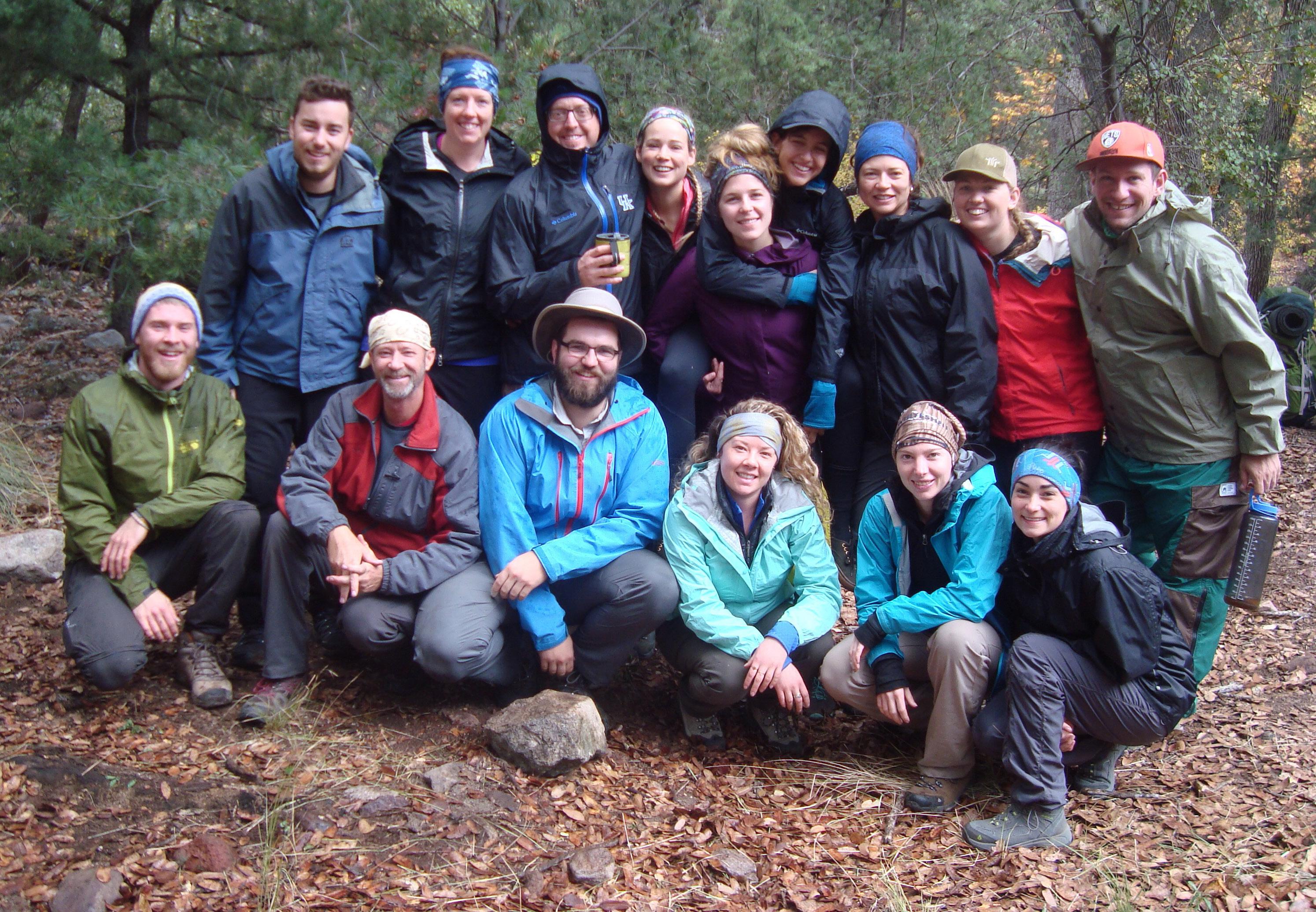
EXPOSE
TIM HORTON CHILDREN’S FOUNDATION
By Ben Lester Custom Education Business Operations Manager
With Reporting By Kim Freitas Writer and PR Specialist
November 19th dawned cold in the Galiuro Mountains of Arizona. High in a valley, amongst the rock and scrub oak, a group of 15 NOLS students and their four instructors rolled from their sleeping bags into the pale grey light. They were tired; the previous day they’d hiked for 10 hours, ending the day bushwhacking in the dark, searching for somewhere to camp. The dry wash where they now lit their stoves to make breakfast was not where they had aimed. Indeed, they hadn’t even found water the night before. And without the room to set up their tents, they’d bivouacked under the stars. They were miles behind schedule, and conflicted about what to do next.
“We had to come to a decision,” remembered Carolyn Carson, a student on the course. “At this point we were quite a bit back from where we were supposed to be and … the route ahead was much more challenging than what we had already faced.”
The Galiuro are not what many think of as a southern Arizona landscape. Just 45 miles northeast of Tucson, the range juts up above the saguaro and cholla cacti of the Sonoran desert, part of an archipelago of about 40 “sky islands”—mountain ranges standing tall and apart above a sea of desert. To the north lie the Rockies. To the south lie the Sierra Madre Occidental. The sky islands are unique.
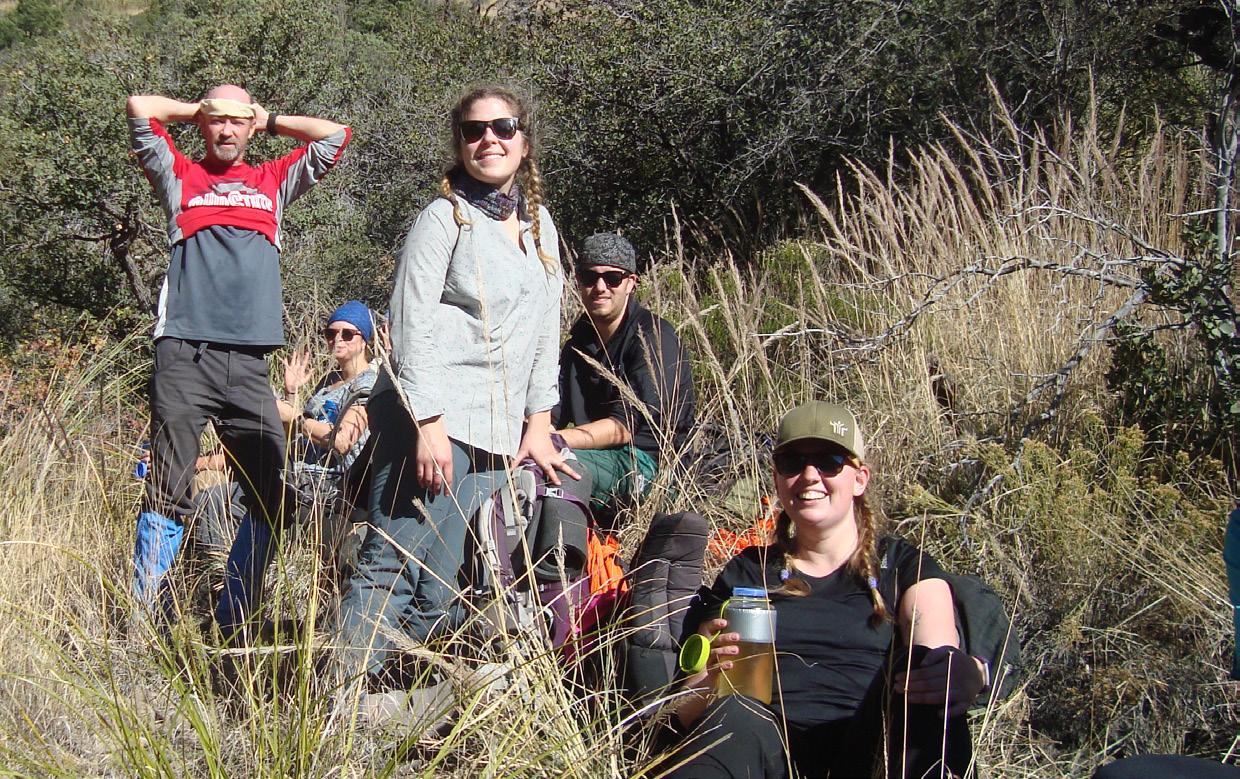
WHAT THE FOUNDATION IS TRYING TO DO, IS GET THE MESSAGE OUT TO KIDS THAT THEY CAN EMPOWER
Over millions of years, as the surrounding land sank and dried to desert, each range evolved its own ecosystem, cut off from others by a moat of arid land. Today, the steep, weathered slopes of the Galiuro lie cloaked in piñon pine, scrub oak, and juniper. Aspens cling to the higher slopes of Bassett Peak, which reaches 7,671 feet. Bears and javalenas, cougars, and bobcats roam the mountains. It’s a rugged landscape where water is scarce for much of the year.
THEMSELVES ...
Carolyn and her coursemates were all administrators from the Tim Horton Children’s Foundation (THCF). THCF runs seven camps across the U.S. and Canada, each open to youth from lowincome families who might not otherwise have the chance to attend a summer camp. The THCF leadership was in the Galiuro to experience the wilderness, because in just eight months they planned to send thousands of campers out into it.
Familiar to all who’ve ever been to Canada as the namesake of the Tim Hortons chain of coffeeshops, THCF was founded on Horton’s death in 1974, “to honor Tim Horton’s love for children, and his desire to help those less fortunate.”
Historically, the program’s focus has been on 9- to 12-yearolds, with a small number of older students continuing on to the foundation’s Youth Leadership Program, a five-year summer program run at one of the foundation’s camps.
“This year, we completely changed styles of programs,” said Mark Johnson, director of program standards at THCF and a student
on the NOLS course. Going forward, all seven camps will focus on the Youth Leadership Program, and each year campers will undertake a wilderness experience at camp. As they progress through the program, they’ll spend more time in the wilderness starting with a onenight overnight at age 12 and culminating in a sevenday, six-night trip at age 16. Activities vary based on each specific camp’s facilities, but many focus on canoeing and backpacking skills.
Each summer, the campers will come to different THCF camp locations for a ten-day session. Campers receive coaching on how to care for others, improve their responsibility and self-motivation, and finish the progression with the tools to succeed after high school.
“What the foundation is trying to do, is get the message out to kids that they can empower themselves and we can help them to find their power, help them to find that direction, their center, to pull themselves up, and to expect more out of themselves than they did beforehand,” said Mark.
Knowing some camps had never hosted a wilderness trip before, THCF went looking for a way to give their staff the same experience they’d soon facilitate for campers new to the program—feeling uncertain, uncomfortable, and that they needed to think fast to adapt to their new surroundings. “We wanted [our staff] to go through the emotions, to go through the stress at their own level, to compare it to what a 13-year-old might feel when they’ve never [gone] backpacking before,” said Mark.
They wanted a challenge and a unique way to grow as an organization. They decided a hands-on outdoor
Taking a break while backpacking in Arizona. Courtsey of Tim Horton Children’s Foundation

recreation trip was the best training opportunity for their staff.
A course with NOLS Custom Education offered the solution. THCF worked with senior account manager Sarah Annarella to design a custom backpacking course in the Southwest. The route selected for the crew was challenging, a six-day meandering loop across the rugged spine of the Galiuro with thousands of feet of elevation gain.
As the crew finished breakfast on that chilly morning in November, they decided together that the goals of the course were best served by turning back the way they’d come, rather than continuing on into the unknown ahead. Expedition members brainstormed solutions, voiced personal opinions, and weighed the pros and cons. Ultimately, they decided to backtrack because they knew the route as well as where the water sources were. This made more sense than pushing ahead, since they were unsure they could reach the route’s distant end-point on time. Instructors let the group puzzle through the decision-making on their own.
“That was a wonderful moment,” remembered Mark. “The decision was made as a group … [it’s] going to be hard but we’ve experienced it, so we know we can do it. We know where the water is along the way.
“Going back is not a failure. This is a smart decision, this is a learning moment,” he continued.
When the team returned from the Galiuro, they debriefed the experience with others at THCF. The experience had fulfilled the goal they’d set out with— to give
their senior staff a true wilderness experience.
For Carolyn, who directs camp operations at THCF, interacting with colleagues in a new environment was a highlight. “I think it’s very interesting to go on a trip like that ... with a group of people you work with and having that opportunity to bond and go through that experience together … There was a tremendous amount of learning,” she said. “Everyone was pushed out of their personal comfort zone.”
Mark saw the new confidence it bred in the THCF team. “That trip ... was a great way to not only open people’s eyes to what it was like but also let them know that, yeah they can totally do that. Just because

Students bonding on their backpacking course. Courtsey of Tim Horton Children’s Founation
Backpacking through the mountains on a clear summer day. Courtsey of Tim Horton Children’s Founation
somebody hasn’t led multiple canoe trips doesn’t mean that they can’t have an understanding for what it takes, until they see that experience and apply that understanding to training staff,” he said.
But, he continued, it had gone further than that. The experience had given the THCF group an up-close look at the behind-the-scenes aspects that make NOLS courses successes—Everything from how instructors work as a team to how the school sets up procedures to manage risk.
They came to realize that their camp staff would benefit from additional training in those less visible components. THCF is an international program, involving hundreds of staff and thousands of campers. All seven of their camps were going to run wilderness trips this summer, and some had never facilitated this type of outdoor trip before.
WE NEED[ED] TO GET MORE PEOPLE TO EXPERIENCE THE PERSPECTIVE OF OUR AWESOME NOLS INSTRUCTORS.
Again, they turned to NOLS.
In April 2017, NOLS Risk Services led a two-day Risk Management Training in Ontario for THCF staff. “We need[ed] to get more people to experience the perspective of our awesome NOLS instructors,” said Mark.
THCF brought in 29 people from all levels of their organization, and for two days the crew talked about “building customized risk management systems for their new programs. Everything from roles and responsibilities, to considerations for staff hiring, to medical screening, to evacuation protocols. A big question we talked about was how to assess whether new activities are appropriate for your mission,” said Katie Baum Mettenbrink, who leads NOLS Risk Services and headed up the THCF training.
“They were incredibly engaged,” she continued. “They were a joy. They have really mission-driven staff who are bought into the organization, and the direction the organization is going, and the value that it will bring to campers. They are highly invested in trying to do it right. They’ve put an extraordinary amount of time into planning a high quality program, rather than just ‘pulling it off.’ And that was reflected at all levels of the organization.”
“It was less about Katie and Jim [Culver, a senior instructor who also worked the training] standing up and saying ‘don’t do this, don’t do that’ and it was more about them asking questions,” remembered Mark. “It was very much an ongoing conversation.” In addition, the NOLS team talked about how THCF should train their own staff going forward.
Leaving the training, THCF staff felt they had identified where their risk management practices were strong, as well as things they could improve upon. “It was really important for some of our staff to realize that we had good plans in place,” said Mark. “It’s easy to question what you do when you are only talking to people that you always talk to but to have somebody, folks like Katie and Jim, come in and look at some of the things we’re doing and say, ‘Well, you already
have some great things that you are doing. Let’s just help you do that more.’”
Combining a NOLS Risk Services training and a NOLS Custom Education expedition gave the team from THCF a multi-level look at how NOLS manages the complex work of supporting thousands of students a year on hundreds of wilderness expeditions, and the confidence to bring their own students the same experiences.
“It’s just an amazing organization to work for,” said Carolyn of THCF. “The work that we are doing, the youth that we are able to serve ... the chance to come to camp and really grow and unlock that potential that is already in them is just such a unique and special experience.”
“I’m really looking forward to hearing from our staff who are going to be supervising our lead wilderness counselors,” said Mark of the coming summer. “I’m looking forward to [hearing] how they are going to apply those experiences [with NOLS] to staff training and in turn to leading those trips this summer.”


Ben Lester
Ben is a recovering journalist and was the editor of A Worthy Expedition: The History of NOLS. As the business operations manager for custom education, he balances office time with teaching field courses.
Having fun backpacking through Arizona. Courtsey of Tim Horton Children’s Foundation
CURRICULUM | LEARNING GOALS AND OBJECTIVES
By Jamie O’Donnell Expedition Curriculum Manager
Many students reflect back on their NOLS experience and use adjectives like “powerful”, “inspiring,” and “challenging”. We want every student who completes a NOLS course to remember an impactful experience, one that positively changed their life. While these descriptions are riddled with anecdotes of adventure, uncertainty, and spontaneity, a behindthe-scenes plan existed to intentionally take students to new learning heights.
As far back as the early 1970s faculty began writing down what we intended students to learn. Paul Petzoldt spoke eloquently when he said he wanted students to be able “to lead instead of being led, to participate instead of watching, to act ... instead of waiting with idle hands.” He referred to the fundamental skills needed for performance as the “must-knows.” How we have articulated desired learning on NOLS courses has changed since that time and new approaches will support us having greater clarity and consistency.
In 2015, along with the creation
of an education department, a team of senior faculty created a single set of learning goals and objectives that encompasses all NOLS courses, from a two-day Wilderness First Aid course to a yearlong expedition in Patagonia. While NOLS staff used learning objectives over the years, this team made two fundamental changes in this revision: they adopted a set of overarching learning goals and framed learning objectives to articulate what we want students to be able to do upon completion of their course.
Early discussions that contributed to the revision process circled around a metaphor: “the magic of a NOLS course.” We crafted a collection of overarching learning goals to articulate learning that may be difficult to measure, but lies at the core of what we want students to achieve and how we instruct NOLS courses, e.g., NOLS graduates will be able to act with confidence and competence. Faculty do many specific things as educators that support learning. While it may feel magical, many thoughtful decisions by faculty each day help our students achieve the

learning goals we crafted.
Additionally, we chose to carefully implement language in our new learning objectives that framed learning in terms of what students will be able to do once they finish their course rather than expectations of performance on their course. While subtle, this change helps faculty and students’ remember that everything we do is intended to influence students lives after their course. What we really want is for our graduates to move forward inspired and empowered to act throughout their lives.
Our learning goals and objectives provide numerous benefits. They inform course descriptions, evaluations, and staff training. As we develop new programs of varying length and focus, these tools give structure to course design. They allow us to focus our language about our courses in terms of what our students will learn. And they help ensure we remain grounded in our values and continue to serve our mission: “To be the leading source and teacher of wilderness skills and leadership that serve people and the environment.”
Read the Learning Goals and Objectives on page 4 of this issue and learn more about curriculum on our website: https://www.nols.edu/en/about/ curriculum/

Jamie O’Donnell
Jamie graduated from a Wind River Mountaineering expedition in 1994. He works as the expedition curriculum manager, as a field instructor, and as a wilderness medicine instructor.
Teaching students on a sea kayaking course in Alaska. STEP Tracy Baynes
RESEARCH | PERCEPTIONS OF WILDERNESS
By Sara Gress Researcher
During the summer of 2014, students participating in the Gateway Scholarship program took to the mountains, rivers, and seas of the American West and Alaska for backpacking, horsepacking, and sea kayaking courses. After their courses, these students, along with non-scholarship students, participated in a study about their views and perceptions of wilderness before and after the course, and how and why these views changed during the course. The Gateway Scholarship program is a part of the diversity initiative at NOLS, partnering NOLS with community-based organizations and schools to provide under-resourced individuals scholarships for NOLS courses. A graduate student and professor at Oregon State University conducted the study with NOLS.
All Gateway’s scholars and a proportionally representative sample of non-Gateway students from the same NOLS courses were invited via email to participate in the study. The students were asked to fill out an online survey and volunteer for a phone interview. The online survey measured students’ attitudes and perceptions about wilderness pre- and post-course; the phone interview asked why students’ perceptions of wilderness did or did not change during the course.
Scores for both groups, Gateway scholars and non-scholarship students, showed that while both entered their courses with positive perceptions of wilderness, non-scholarship students possessed significantly more positive pre-course beliefs about wilderness. After the course, both groups scored almost identically, with both experiencing positive change in their perceptions of wilderness.
Interview data revealed potential

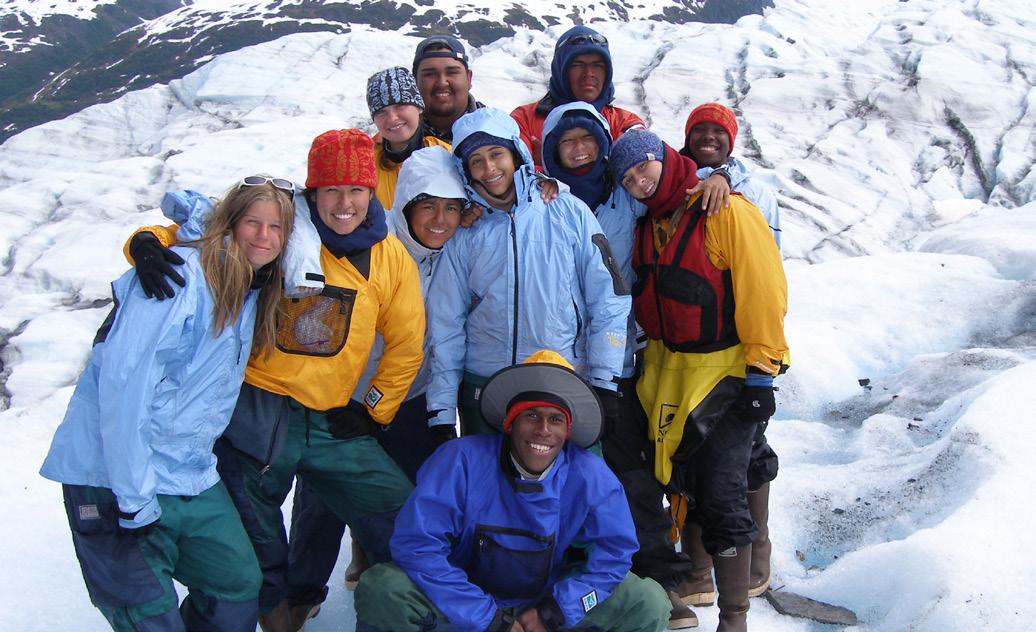
reasons for attitude change, including learning course content (e.g., Leave No Trace, wilderness medicine), gaining a deeper personal connection to wilderness, and developing a heightened awareness of environmental issues. Two potential implications for outdoor experiential education practitioners were revealed by the survey and interview data.
First, it was apparent that the NOLS curriculum effectively conveyed the benefits of wilderness. However, this message alone may de-emphasize closer-to-home ecologies (“non-wilderness”), such as a wetland or river nearby a student’s home, that are also important to the planet’s well-being. Students typically mentioned how their course fostered a greater appreciation of wilderness, but then commented on the economic barriers to participating in another course, because of the cost and distance of reaching “wilderness.”
Second, the interview data revealed that, in some instances, the discussion about wilderness was experienced differentially, with Gateway scholars typically experiencing more challenges to their identity and pre-course attitudes
than non-Gateway students. This is not to say that Gateway students did not feel comfortable or welcome in the wilderness: students’ course experience scores were not different between non-Gateway and Gateway scholars. The interview data also suggested that students felt that they belonged in wilderness. If the goal is to diversify the NOLS student population, it is worth considering how NOLS communicates the concept of wilderness, with sensitivity to how that message is being received by different audiences, both before and during courses. This could assist in recruiting students of all backgrounds.

Sara
Gress
Sara received her M.S. in Forest Ecosystems & Society from Oregon State University. She lives in Hailey, ID, and has figured out how to pay the bills with her chainsaw, first responder certification, and skiing skills.
Left: Landscape of the Wind River Range Justin Loyka Right: NOLS aims to grow in diversity through the Gateway Scholarship program. STEP Tracy Baynes
HOW TO | LIGHTWEIGHT BACKPACKING
By Benji Whitcomb NOLS Alaska Equipment Manager and Instructor
You’ve decided you want to hike the John Muir Trail, tackle the long miles of the Pacific Crest Trail, or maybe navigate the off trail challenges of the Continental Divide Trail. To you, a long day on the trail seems more like a chore of back pain management than an attainable journey through the wilderness. The good news is that solutions aren’t far from your reach.

When thinking about going light it’s critical to develop and understand the mindset first. Throw out the notion of comfy pillows and Crazy Creek reclining chairs. Adopt the ideas of minimalism and multi-use. How can I find a lighter item and how can I use it for multiple tasks? The next three steps outline key areas that can shave weight and provide the needed momentum to ignite your lightweight thru-hiking dreams.
Step 1 | Choose Your Pack
Modern lightweight packs are free of extra straps, excess zippers, and fluffy hip straps that seem nice on the surface but only add unneeded weight with no real function in the minimalist scene. Heavier and larger packs look comfortable but only encourage you filling them up to the brim. Look for packs that hold 35-45 liters and provide limited frills.
• Total weight is less than 2.5 lbs
• Durable ripstop materials
• Limited straps, zippers, and pockets
• No extra “brain” for storage
Step 2 | Choose Your Clothing and Footwear
Gone are the days of heavy wool sweaters and clunky leather boots. The newest down and synthetic materials provide excellent warmth with minimal weight. The price tags are high, but you’ll also have high energy levels at the end of a long day. Hunt down the best trail running shoes that fit your needs. They’re sturdy, have great traction, and, unlike leather boots, don’t feel like you have cement on your feet even when wet.
• 800+ fill down provides the most warmth to weight ratio on the market
• Hooded garments provide a built-in hat
• Keep pants, shirts, socks, and underwear to a quantity of one.
• A lightweight windshirt can sometimes double as a rain jacket.
Step 3 | Choose Your Bedroom and Kitchen
Much like modern clothing options, there are multiple sleeping bag choices. Ultra-light 800+ fill down sleeping bags provide excellent warmth and packing
ability. Choose a warmer rating than you might have in the past. Summer months can warrant a 35- to 40- degree bag. If you’re cold, slip on all of your layers to sleep warm. The stove options are endless as well. Canister stoves provide easy, fast use while denatured alcohol stoves are even lighter, but can require precision fuel measurements to accurately plan out fuel consumption.
• Use your sleeping bag in camp for warm layers instead of long underwear.
• Your backpack can double as part of your sleeping pad.
• Plan or purchase premade meals that only require boiling water.
• Consider going stoveless! Bring only foods that do not require cooking.
• Tents and tent poles can be heavy. Opt for simple tarps or bivvy bags.
These steps will only get you started in the right direction. It takes weeks of on-trail experience to know what works for you and what items you can cut out of your system. Make sure you plan for your environment appropriately. If you think it will be wet you might consider more synthetic options than down-filled options. Push yourself to do without. Chop down the toothbrush, leave the toilet paper behind, and head forth into the wilderness as the new, lighter you.

Students hike on a lightweight course. Jared Steinman
Benji Whitcomb
Benji is the equipment manager for NOLS Alaska as well as a field instructor. He enjoys cycling, hiking, and planning his next mountaineering trip.
HOW TO | HYDRATION TIPS FOR CAMPING
By Tod Schimelpfenig NOLS Wilderness Medicine Curriculum Director
Now that summer has officially arrived, we can enjoy the hot temperatures, lush wildflowers, and rivers full of snowmelt. It brings to mind the need to stay hydrated. Maintaining water balance, in addition to preventing dehydration, helps our tolerance to heat, altitude, and cold challenges. The mantra of “hydrate, hydrate, and hydrate” is heard throughout the wilderness world. Hydration is important to health, yet over-hydration can make us ill.
How much water should I drink? What temperature is best? What about salt and sugar? There are many answers to these questions depending on your physiology, activity, and environmental conditions, and, of course, on who you ask. The hydration needs of a sedentary and an active person will differ. We exercise at different rates, in heat and cold, dry air and humid air, at sea level and at altitude. Crafting one recommendation is challenging.
Competitive athletes often become very sensitive to exactly how much fluid they need. At NOLS, we take the middle of the road and recommend 1/2 liter for every hour of moderately strenuous activity in moderately hot weather and a general target of drinking 4-5 liters a day while backpacking in the mountains. As you gain experience, you can fine-tune your intake. Monitor your urine output for color and quantity—dark urine is a sign of dehydration, as are fatigue, irritability, poor thinking, thirst, and headache. Enjoy your sipped hot or iced drink, but hydrate with cool or warm drinks.
There is some data favoring the absorption of cool over warm beverages, but the differences would only impress a research scientist and probably don’t have a noticeable impact in the real world.

Get your hydration fix at the NOLS store | store.nols.edu Kirk Rasmussen
Likewise, most sports drinks have acceptable concentrations of sugar. Palatability seems as good a choice point as any. People argue whether sugar should be simple, complex or polymerized carbohydrate, and whether sports drinks provide enough sodium. This is primarily of interest to competitive athletes. On a wilderness expedition, I don’t get my nutrition by gulping a drink or an energy gel at a race rest station. My daily carbohydrate intake is based on meals and on-trail snacks.
The emphasis on hydration has brought to light the dangers of hyponatremia—low blood sodium from overhydration. Prominent examples in the press have included Grand Canyon hikers and marathon runners. The hikers drink lots of water and don’t balance this with food—a source of electrolytes. The marathon runners are diligent in stopping at every drink station and ingest more fluid
than they are losing through sweat. High fluid intake, say several liters in the past few hours, should make you suspicious for hyponatremia/overhydration.
Prevention, to quote wilderness medicine guru Buck Tilton, is “a matter of being sensible, which is so often the case.” Be self-aware. Monitor how you feel, your urine output, and fluid intake. As with so many things in the wilderness, it is much easier to stay hydrated than to treat dehydration.
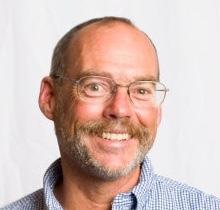
Tod Schimelpfenig
Tod is the curriculum director for NOLS Wilderness Medicine and has worked at NOLS for 43 years.
REVIEWS | MUSIC

OLEA
By Amanda Winterhalter NOLS grad
Rock guitar solos, twangy folk tunes, somber ballads, and powerful melodies all characterize the music of Amanda Winterhalter. Winner of the 2016 Tumbleweed Music Festival Songwriting Contest, Amanda is a lyrical poet, and like storytellers of old, she meshes her own experience with the tales and traditions of others to inspire vivid and varied accounts of the human experience. A master of her craft, Amanda ensnares listeners with the first few lines of the songs on her new album Olea, and quickly immerses them in emotional scenes, from impassioned love affairs to lonesome heartache.
While her early years remain somewhat of a mystery, Amanda’s blog tells us that she studied English in college and began performing on “Seattle stages ranging from clubs to concert halls” in 2012. Amanda took a NOLS course in 2016 and shared this thought in a post soon after:
“When I returned home, it felt abnormal to wake up in a house. After spending a month outside, having four solid walls around me felt too easy, too sterile. Walls just can’t compare to mountains. And though I will never take indoor plumbing for granted, a bathtub just isn’t the same as a glacier pool.”
Reviewed by Nick Knoke, Marketing Specialist. © 2016, Amanda Winterhalter

NOW THAT THE LIGHT IS FADING
By Maggie Rogers NOLS grad
If you haven’t listened to Maggie Rogers’ hit song “Alaska,” you need to. Hauntingly beautiful, with a rustic—almost tribal—beat, the song charmed thousands of listeners, including music artist Pharrell Williams. Maggie’s humble, non-traditional manner is sure to have charmed thousands more as her yearlong world tour comes to a close. Originally, Maggie came from rural Maryland where she enjoyed making banjo music, hiking, and exploring the great outdoors. During college she spent a semester abroad in France and “had a really spiritual experience with dance music there,” despite having previously found dance, trance, and techno music to be the most “unnatural and artificial” forms of music. During an NYU masterclass, visiting artist Pharrell said Maggie is “doing her own thing [...] her whole story, I can hear it in the music.”
In 2013 Rogers took a NOLS course that would later serve as inspiration for her hit single “Alaska,” where she sought to “combine folk imagery, harmony, and natural samples from hiking trips, with the backbone and energy of dance music.” Before going on tour, Rogers put out an EP with three similarly avant-garde tunes that continue to showcase her diverse pool of inspiration and worldly experience.
Reviewed by Nick Knoke, Marketing Specialist. © 2017, Capitol Records
Who Is This?
The answer to last issue’s “Who is This” is longtime field instructor, former Patagonia Program Director, and current Development Officer Judd Rogers.

GEAR REVIEW | DEUTER EXPEDITION 90+10 BACKPACK
By Lucas Schwandt NOLS grad
The Deuter Expedition 90+10 pack is the field tested, hard wearing, battle axe of lore. And like a trusty battle axe, it’s simple and on the heavier side, but the tradeoff is knowing you have a totally bomber pack that isn’t going to let you down. Which is why NOLS students and instructors alike come to trust and value the Deuter for what it is: a steadfast backcountry companion.
Many arguments could be made about which piece of gear is most essential, but the answer is simple: it’s your backpack. None of your gear is getting anywhere without a reliable pack, which is where the Deuter comes in.
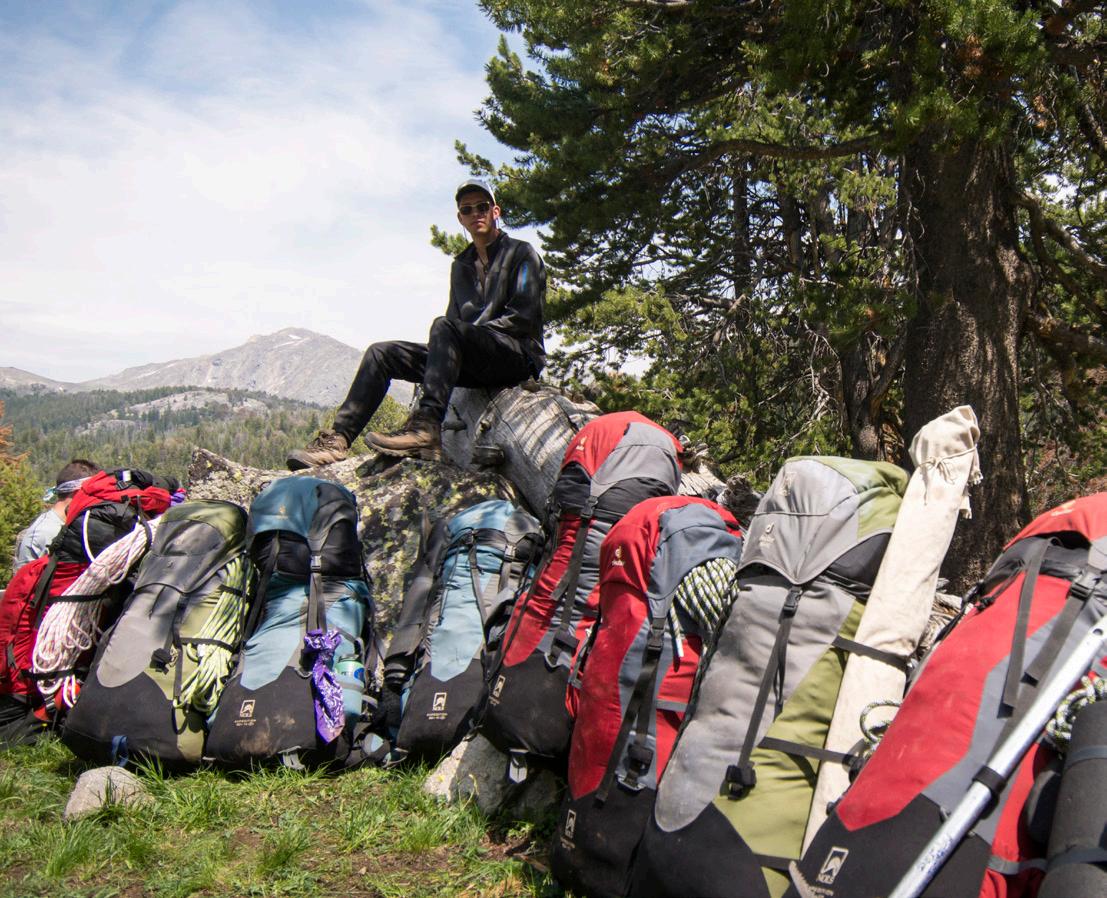
Here’s a quick rundown of what really gives this pack value in a NOLS expedition setting:
• In a world of uniquely shaped individuals, the Deuter does a good job at being adjustable.
• The shoulder straps are nothing fancy, but they work very well, have 12 positions of adjustability, and are burly enough to stand up to hard daily use. Same goes for the hip belt: it has two hip pockets for quick access that can easily accommodate sunscreen, trail goodies, and of course a small digital camera, which are essential for capturing the exciting moments of an expedition!
• The aluminum pack stays are able to be removed and shaped to the
contour of the wearer.
• The giant tube-with-shoulder-straps design of the Deuter allows you to very easily waterproof the inside of the pack with anything, from a high end dry bag to a simple trash compactor bag. Just throw the liner in and get to packing!
• It allows the wearer lots of mobility for crawling around in canyons, scrambling over rocks, and threading your way through narrow spots, without having bulky external pockets and straps to get hung up on trees and rocks.
• The Deuter has an ample sized “brain” on top that allows you to easily fit your snacks, maps, GPS, water treatment, and whatever daily essential items you may need to get to quickly and easily.
• Heavyweight nylon fabric stands up to lots of abuse, and you really have to work hard (like really hard) to rip or tear it’s stitching.
During my NOLS course, I personally spent many mornings stuffing my Deuter Expedition pack to the gills, and wondering how I would fit everything after a reration. My pack didn’t just put up with, but excelled at being dragged, passed, and floated through the beautiful canyons of Utah. It even went skiing with me. It has been the piece of gear I have come to trust and depend on most in the backcountry. Simply put, it has everything you need, and nothing you don’t, which makes it ideal for enjoying the rugged beauty this country has to offer.
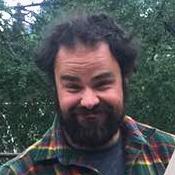
Lucas Schwandt
Lucas recently graduated from Central Wyoming College with a degree in Outdoor Education and Leadership, and his stoke level is high. He can be found traveling the outdoors on some form of twowheeled transportation.
The Deuter Expedition 90+10 pack. Jared Steinman
NUTRITION | WHAT TO EAT IN THE BACKCOUNTRY
By Madeline Lindley Graphic Design Intern
It’s day five on your two-week journey and you wake up to a dry tent and a spirit for adventure. ‘It’s going to be a great day,’ you say to yourself. Then your stomach starts to grumble. You’re hungry and you know what’s coming. You sheepishly crawl out of your sleeping bag and begin the morning routine of searching your
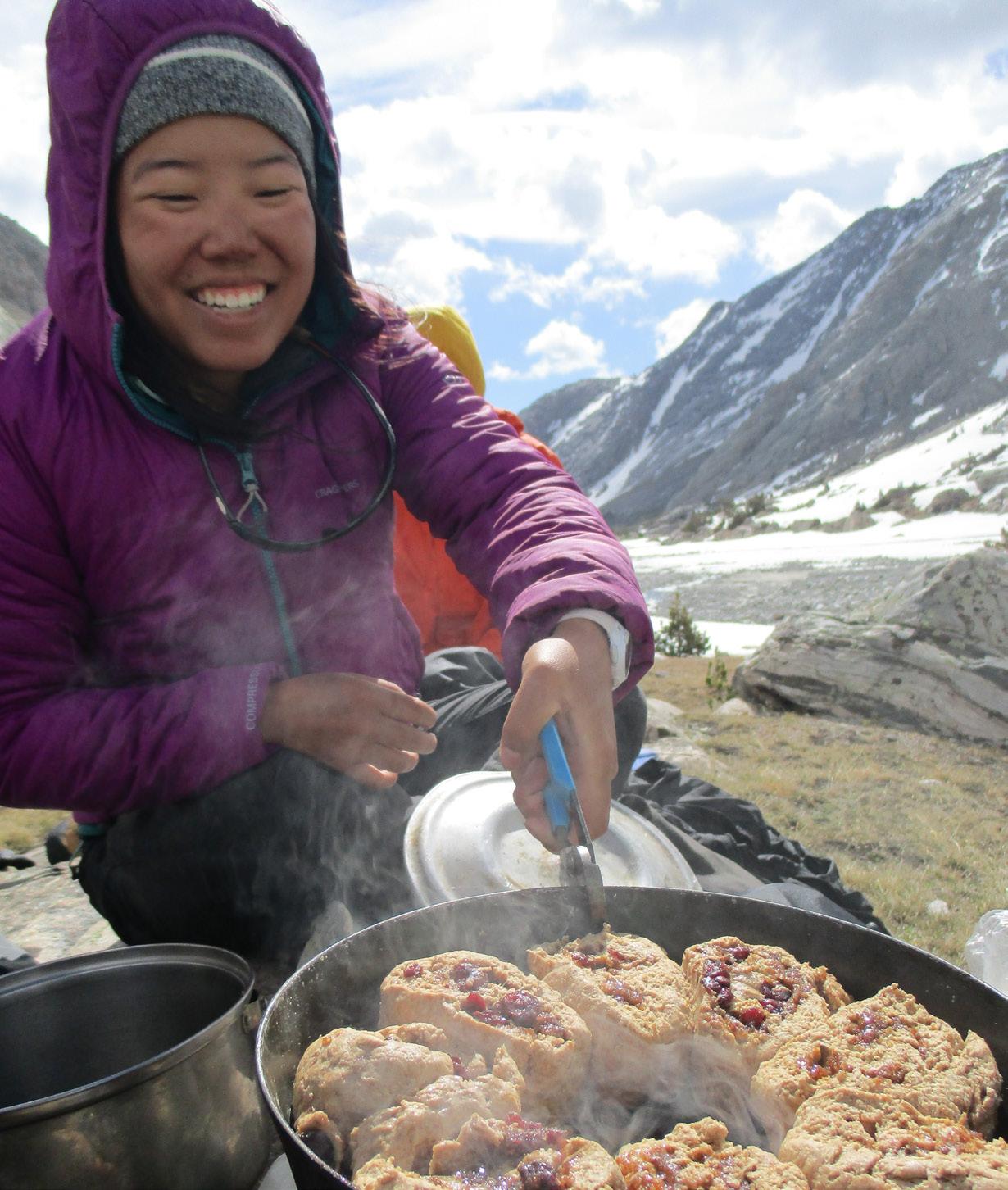
stash for your oatmeal packet. Brown maple sugar, again. You don’t love it, but it provides you with enough macronutrients (energy from food) to get you through the morning. Or does it?
Our bodies can burn as many as 10,000 additional calories from activity, making it all the more important to consume the right ratio of carbohydrates, proteins, and fats at the right times. Consider these tips when prepping your next backcountry menu.
• Pack sugary, starchy snacks – Sugars and starches, which make up carbohydrates, take on the role of being the fastest source of energy of all macronutrients. So in order to avoid that mid-day slump, load up on carb heavy snacks. Think nut and chocolate trail mixes, fruit snacks, coconut, or even a Snickers bar.
• Fill morning meals with fats – Fat is another great energy source, but it burns slowly, taking up to six hours to digest. Focusing on eating fat heavy foods in the morning will help your body maintain energy levels later in the day. Add peanut butter to your oatmeal, butter to your coffee, or fry pancakes in coconut oil.
• Recover with proteins – Proteins, which are comprised of long chains of amino acids, break down and and reconstruct in the body to aid in cell repair and new tissue growth. After a long day of activity, pull out some proteins to snack on upon arriving at camp, such as cheese and crackers, pumpkin seeds, or beef jerky.
Of course it’s important to maintain a balance of all macronutrients throughout the day; however, understanding the energy efficiencies of each will allow you to go further, faster.

Madeline Lindley
Madeline is a firm believer in the freeing power of laughter. For this reason, when she’s not sketching up new designs, she can be found jumping in puddles or singing car karaoke a little too loud.
ANSWER | Adirondack State Park, which is about 6 million acres.
Wilderness Quiz
Cinnamon rolls are a great way to start the morning with fats. Will Harrison
“My



–Sophia Swart NOLS grad
Courtesy of Sophia Swart

